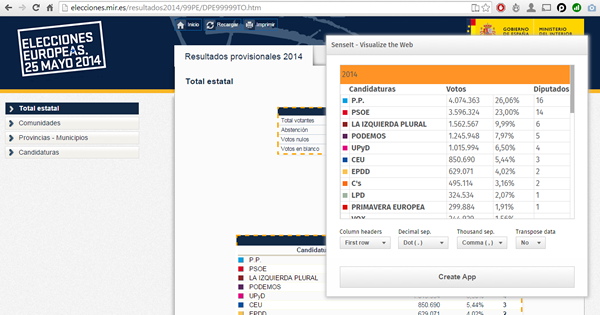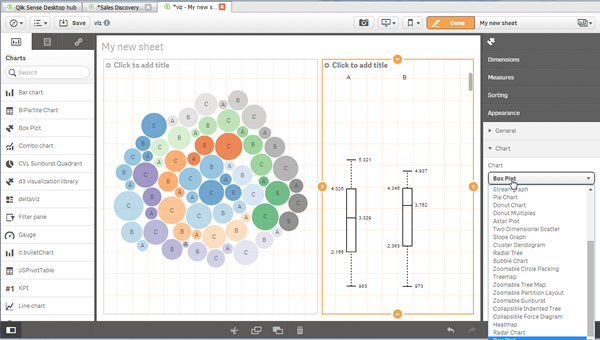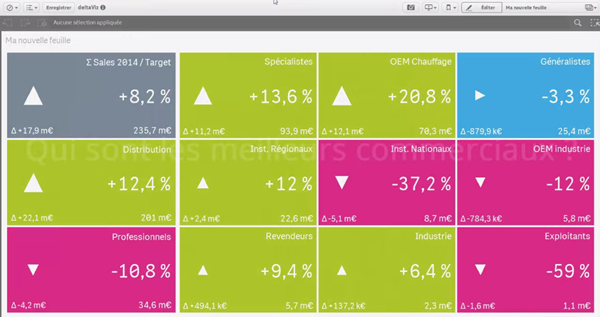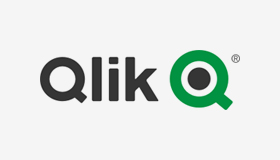Unlock a world of possibilities! Login now and discover the exclusive benefits awaiting you.
Product Innovation
By reading the Product Innovation blog, you will learn about what's new across all of the products in our growing Qlik product portfolio.
Support Updates
The Support Updates blog delivers important and useful Qlik Support information about end-of-product support, new service releases, and general support topics.
Qlik Academic Program
This blog was created for professors and students using Qlik within academia.
Community News
Hear it from your Community Managers! The Community News blog provides updates about the Qlik Community Platform and other news and important announcements.
Qlik Digest
The Qlik Digest is your essential monthly low-down of the need-to-know product updates, events, and resources from Qlik.
Qlik Learning
The Qlik Learning blog offers information about the latest updates to our courses and programs, as well as insights from the Qlik Learning team.
Recent Blog Posts
-
Qlik Replicate and an update on Salesforce “Use Any API Client” Permission Depre...
Dear Qlik Replicate customers, Salesforce announced (October 31st, 2025) that it is postponing the deprecation of the Use Any API Client user permission. See Deprecating "Use Any API Client" User Permission for details. Qlik will keep the OAUT plans on the roadmap to deliver them in time with Salesforce's updated plans. Salesforce has announced the deprecation of the Use Any API Client user permission. For details, see Deprecating "Use Any API ... Show MoreDear Qlik Replicate customers,
Salesforce announced (October 31st, 2025) that it is postponing the deprecation of the Use Any API Client user permission. See Deprecating "Use Any API Client" User Permission for details.
Qlik will keep the OAUT plans on the roadmap to deliver them in time with Salesforce's updated plans.
Salesforce has announced the deprecation of the Use Any API Client user permission. For details, see Deprecating "Use Any API Client" User Permission | help.salesforce.com.
We understand that this is a security-related change, and Qlik is actively addressing it by developing Qlik Replicate support for OAuth Authentication. This work is a top priority for our team at present.
If you are affected by this change and have activated access policies relying on this permission, we recommend reaching out to Salesforce to request an extension. We are aware that some customers have successfully obtained an additional month of access.
By the end of this extension period, we expect to have an alternative solution in place using OAuth.
Customers using the Qlik Replicate tool to read data from the Salesforce source should be aware of this change.Thank you for your understanding and cooperation as we work to ensure a smooth transition.
If you have any questions, we're happy to assist. Reply to this blog post or take your queries to our Support Chat.Thank you for choosing Qlik,
Qlik Support -
Unlock Your Qlik Superpower
Discover your current skill level and receive recommendations to accelerate your learning. Access the new Skills Assessments free and receive training recommendations designed to strengthen and expand your skills. -
Qlik Sense November 2025 (Client-Managed) now available!
What’s New & What It Means for YouWe’re excited to announce the November 2025 release of Qlik Sense Enterprise on Windows. This update brings enhancements across app settings, visualizations, dashboards, and connectors making your analytics smoother, more powerful and easier to maintain. Below is a breakdown of the key features, how your teams – analytics creators, business users, data integrators and administrators – can benefit, and some practi... Show MoreWhat’s New & What It Means for You
We’re excited to announce the November 2025 release of Qlik Sense Enterprise on Windows. This update brings enhancements across app settings, visualizations, dashboards, and connectors making your analytics smoother, more powerful and easier to maintain. Below is a breakdown of the key features, how your teams – analytics creators, business users, data integrators and administrators – can benefit, and some practical next-steps to get ready. -
-
【2026/1/27(火)15:00 開催】AI の未来を創る:データ・エージェント・人間のタッグが生む新たな価値
AI を活用して投資利益率を高める 2026年のトレンド 多くの企業が AI に投資しているにもかかわらず、投資利益率を高めている企業はごく少数です。何を改善すべきなのか? 何十年もの間、企業は振り子のように揺れ動いてきました。前進している時は自由度を高め、後退している時は規律を強める…を繰り返してきました。2026年のデータで成功する戦略モデルは、二者択一ではありません。管理とイノベーションを両立して活かし、新たな価値を生み出すことが重要になります。 1月 27日(火)開催 Web セミナー「AI の未来を創る:データ・エージェント・人間のタッグが生む新たな価値」では、Qlik のマーケットインテリジェンスリードの Dan Sommer と Qlik APAC の分析・AI 部門 最高技責任者の Charlie Farah が、2026年の重要なトレンドについて解説します。 本 Web セミナーでは、ビジネスを成功に導くために押さえるべき 3 つの重要なポイントをご紹介します。このポ... Show MoreAI を活用して投資利益率を高める 2026年のトレンド
多くの企業が AI に投資しているにもかかわらず、投資利益率を高めている企業はごく少数です。何を改善すべきなのか?
何十年もの間、企業は振り子のように揺れ動いてきました。前進している時は自由度を高め、後退している時は規律を強める…を繰り返してきました。2026年のデータで成功する戦略モデルは、二者択一ではありません。管理とイノベーションを両立して活かし、新たな価値を生み出すことが重要になります。
1月 27日(火)開催 Web セミナー「AI の未来を創る:データ・エージェント・人間のタッグが生む新たな価値」では、Qlik のマーケットインテリジェンスリードの Dan Sommer と Qlik APAC の分析・AI 部門 最高技責任者の Charlie Farah が、2026年の重要なトレンドについて解説します。
本 Web セミナーでは、ビジネスを成功に導くために押さえるべき 3 つの重要なポイントをご紹介します。このポイントをビジネスに適用すると、データの整合性を確保してすべてのシステムをシームレスにつなぎ、ビジネスに革新を起こすことができます。さらに、この新たなモデルの基礎となるトレンドを探ることで、貴社のデータ戦略をレベルアップする方法も解説します。
偏った方針に振り回されることなく、分断を解消して統合基盤を構築するには?Web セミナーに参加して、AI を最大限に活用するために、新たなモデルの導入の重要性をご確認ください。
※ 参加費無料。日本語字幕付きでお届けします。パソコン・タブレット・スマートフォンで、どこからでもご参加・ご視聴いただけます。
-
Dynamic Engine Now Supports Google Kubernetes Engine: Deploy Anywhere, Scale Eve...
The evolution of enterprise cloud strategy is no longer about choosing a single provider - it's about deploying flexibly across AWS, Azure, Google Cloud, and on-premises infrastructure, depending on the unique needs of your business, industry, and regulatory environment. Today, we're excited to announce that Qlik Talend Dynamic Engine officially supports Google Kubernetes Engine (GKE), joining our existing support for AWS EKS, Azure AKS, and on-p... Show MoreThe evolution of enterprise cloud strategy is no longer about choosing a single provider - it's about deploying flexibly across AWS, Azure, Google Cloud, and on-premises infrastructure, depending on the unique needs of your business, industry, and regulatory environment. Today, we're excited to announce that Qlik Talend Dynamic Engine officially supports Google Kubernetes Engine (GKE), joining our existing support for AWS EKS, Azure AKS, and on-premises Kubernetes distributions like RKE2 and K3S.
-
Write Table now available in Qlik Cloud Analytics
Introducing Write Table a simple, interactive way for users to work directly with their data inside their analytics apps -
統合が進む市場では、データ統合が競争優位を左右する(Qlik Blog 翻訳)
ブログ著者:Drew Clarke 本ブログは「In a Consolidating Market, Data Integration Is Your Control Point」の翻訳になります。 Gartner 社は、「Gartner® データ統合ツールの Magic Quadrant」において、再び Qlik をリーダーの 1 社として評価しました。Qlik は、今回で 10年連続の快挙を達成しました。この 10年間、データ統合を取り巻く環境は大きく変化しました。大規模なクラウドコンピューティングサービスを提供する企業群は存在感を高め、大手ベンダーは囲い込みを強化してきました。さらに、企業の買収が顧客の選択肢そのものを再編しています。 市場の統合が進んでいる今、最高情報責任者や最高データ責任者が考えるべきポイントが変わってきています。「Magic Quadrant のポジション」よりも、「自社のデータおよび AI 戦略の推進と継続性」が重要になっています。Deloitte 社が実... Show Moreブログ著者:Drew Clarke
本ブログは「In a Consolidating Market, Data Integration Is Your Control Point」の翻訳になります。Gartner 社は、「Gartner® データ統合ツールの Magic Quadrant」において、再び Qlik をリーダーの 1 社として評価しました。Qlik は、今回で 10年連続の快挙を達成しました。この 10年間、データ統合を取り巻く環境は大きく変化しました。大規模なクラウドコンピューティングサービスを提供する企業群は存在感を高め、大手ベンダーは囲い込みを強化してきました。さらに、企業の買収が顧客の選択肢そのものを再編しています。
市場の統合が進んでいる今、最高情報責任者や最高データ責任者が考えるべきポイントが変わってきています。「Magic Quadrant のポジション」よりも、「自社のデータおよび AI 戦略の推進と継続性」が重要になっています。Deloitte 社が実施したグローバル CIO 調査においても同じ方向性が示されました。クラウドや AI を活用した業務が増えているが、ベンダー依存の回避とアーキテクチャの柔軟性の維持が、これまで以上に重要な課題となっています。
リアルタイム・ハイブリッド・オープン
高性能な CDC(変更データキャプチャ)と複製
Qlik のログベースの変更データキャプチャおよび複製は、市場でもトップクラスと評価されています。データベース・メインフレーム・クラウドなど、あらゆる環境間で信頼性の高いリアルタイムの連携を実現します。これにより、ゼロダウンタイムでハイブリッドクラウドへデータを移行することが可能になり、リアルタイムのリスク管理と業務運用をサポートします。膨大なデータの移行と変換
Gartner 社は、膨大なデータやバッチ処理におけるデータ移行と変換機能のパフォーマンスについても高く評価しています。ここで求められるのは、負荷が増大しても安定して動作し、本番環境での想定外のトラブルを最小限に抑制できることです。これにより、日々の運用維持に縛られずに AI や分析といった新たな価値の創出に注力できるようになります。ハイブリッドおよびマルチクラウド対応の幅広いコネクター
Qlik が提供している幅広いコネクター、オンプレミス・クラウド・レイクハウス環境におけるサポートは、小さな機能や細かい仕様に見えますが、実際は運用の柔軟性をサポートする立役者です。ある業務はオンプレミスで、別の業務は AWS / Azure / Google Cloud で実行するといった柔軟な運用が可能になります。また、新しいデータ形式(Apache Iceberg など)を導入する際に、既存の統合戦略を策定し直す必要もありません。ガバナンス・メタデータ管理・AI 活用への対応
Gartner 社は、Qlik のメタデータ管理とガバナンスを市場の平均以上と評価しており、データパイプライン全体の系統・ポリシーの適用・データの流れの可視化などが含まれます。AI がより重要な業務に介入するようになり、データの出所や利用方法における規制当局の監視が厳しくなっている中、こうした機能はオプションではなく必須となっています。
特許取得済みの Qlik Trust Score for AI は、AI がアシストするパイプライン設計や品質チェックにも活用されており、メタデータ管理とガバナンスの基盤で機能します。管理できるデータのみが、自動化と信頼度評価の対象になります。レイクハウスと AI の活用 - 運用の柔軟性も維持
Qlik のオープンレイクハウスや Apache Iceberg の取り込み、圧縮、ハイブリッド複製に関する取り組みは、先進的なレイクハウス戦略を証明するものだと評価されています。Icebergは、複数の処理エンジンで同じデータを共有できるオープンテーブル形式のため、エンジニアリング・コスト効率・リスク管理のすべてにおいて優れています。
管理された Iceberg テーブルに一度データを置くだけで、データウェアハウス・AI・分析ツールで即座に利用できるようになります。複雑でコストを要する複数のデータのコピーを作成する必要はありません。信頼できるデータ製品、オープンなレイクハウスレイヤー、AI がサポートする統合を組み合わせると、無意識にデータ活用にAI を使えるようになります。個別の特別なプロジェクトとして扱う必要はありません。
統合が進む市場での独立性
Magic Quadrant で見落としがちな一行ですが、Qlik は引き続き独立性を維持し、ハイブリッド環境に対応したオープンプラットフォームを提供しています。
もしデータ統合プラットフォームが CRM ベンダーや主要クラウドが所有している場合、プラットフォームはどうしてもベンダーの都合に合わせた設計になります。ロードマップや価格設定、機能やデータ連携の範囲なども影響を受けます。
一方で、独りした統合プラットフォームなら、自由な選択肢と交渉力を確保することができます。クラウドやデータウェアハウスを自由に組み合わせたり、価値に応じて条件を交渉したり、性能・コスト・規制の変化に応じて柔軟に移行することも可能です。これが私が主張したい「自由」です。自社のビジネスに必要なデータファブリックや AI 環境を設計し、状況の変化に応じてゼロから構築し直すこともなく柔軟に変更できる状態なのです。
まとめ
Magic Quadrant の図を度外視すると、今年のレポートで伝えたいことはシンプルです。リアルタイム対応、ハイブリッド環境、オープンアーキテクチャは、今の標準要件となっています。ガバナンスやメタデータ管理、AI 活用の準備は、意思決定の需要な判断基準になりつつあります。さらに、市場の統合が進む中でも、独立性と柔軟性は変わらず重要です。
この Magic Quadrant の評価は、Qlik の取り組みが正しい方向に進んでいることを示しています。CDC や膨大なデータの移行、コネクタ、ガバナンス、レイクハウス、AI 支援の統合といった一貫した取り組みが評価されたと言えます。
データリーダーが重要視していることは、シンプルです。
- 必要な時に、クラウドやデータウェアハウス、基幹システム間で自由にデータを移行できるのか。移行する度にゼロからやり直す必要はないのか。
- データが AI や規制に対応できる状態であることを、明確な系統、ポリシーの適用、信頼の指標で証明できるのか。
- 単一の統合されたデータ基盤を運用しているのか。もしくは分散したツールを寄せ集めた状態なのか。そして、それがコスト、リスク、スピードにどう影響するのか。
こうしたポイントに対応できるのが、Qlik Talend Cloud / Qlik オープンレイクハウス / AI 支援の統合アプローチです。
データ統合ツール分野で 10年連続でリーダーの 1 社に評価された功績を誇らしく感じますが、本当に重要なのは、実際にプラットフォームを使用した際の自由な操作性と管理を実感いただけることです。
-
【新着レポート】Qlik、データ統合ツールで 10 年連続リーダーの 1 社に!
Gartner 社は、「2025年 Gartner® データ統合ツールの Magic Quadrant」を発表しました。Gartner 社が評価した 20 社のデータ統合メーカーの中で、Qlik は 10 年連続でリーダーの 1 社に評価されました。 データはこれまで以上に多くのシステム間で高速で移行し、AI 主導の意思決定の要となっています。信頼できるデータ統合基盤は、このような状況を支えるだけではなく、極めて重要なものとなっています。自社に最適なプラットフォームを選択するには?本レポートで 詳細をご確認ください。 データ統合市場における Gartner 社 のインサイト Qlik がリーダーの 1 社に評価された理由 データ統合市場における各メーカーの評価 無料レポートを見る -
Some of the best Qlik Sense extensions created so far
Since the release of Sense back in September 2014 a lot of good things have happened to the product. If you look back you almost can’t believe that it was just 6 months ago when we launched Sense. Since then, R&D guys and girls have added quite a lot of improvements and new functionality (and more is coming next) into the product.Today, I don’t want a focus on the company’s centralized development. We talk enough about ourselves here, but on the ... Show MoreSince the release of Sense back in September 2014 a lot of good things have happened to the product. If you look back you almost can’t believe that it was just 6 months ago when we launched Sense. Since then, R&D guys and girls have added quite a lot of improvements and new functionality (and more is coming next) into the product.
Today, I don’t want a focus on the company’s centralized development. We talk enough about ourselves here, but on the decentralized Sense development guerrilla from out there. Since January 26 these individuals contributing with a fresh view to Qlik Sense (to QlikView as well) have a place to share their ideas and Open Source projects. It’s called Qlik Branch and it’s open for everyone to join.
From all the projects already submitted to Qlik Branch, I will nominate 3 of my favorites created so far.

SenseIt by Alex Karlsson
It goes to my personal Top 1 for a variety of reasons but particularly because it opens a completely new and unexplored category for Extensions. We are used to seeing extensions (or visualizations) within the product itself but this is something completely different. SenseIt is a browser extension or plugin that will let you create a new app on the fly by capturing a table from Chrome and loading it as data into your Qlik Sense Desktop. Truly amazing experience and the name is cool too (isn’t it?)

D3 Visualization Library by Speros Kokenes
As a visualization junkie I am, I love D3.js, I truly love some of the beautiful and smart visualizations built around the popular JavaScript library. I have seen (and ported) some of those charts to Sense, one by one, so you end up having a packed chart library on your Sense desktop. Speros have gone a bit further by converting the Visualization object into a truly D3js library where you can go and pick up your favorite D3js visualization, very entertaining. In future releases we might end up having control over the chart colors and some other cool stuff that will make this extension superb, remember you can contribute and make it even better.

deltaViz self-service dashboard by Yves Blake
For those of us QlikView lovers any addition to the dashboard world in Sense it’s always very much appreciated. If it’s very well executed and designed as it is deltaViz, then there’s no reason to not try it. DetalViz is a complete solution for dashboards focused on comparisons and very well implemented to take advantage of Qlik Sense grid system. If you still have doubts about this visualization, you can see it live here: https://www.youtube.com/watch?v=4s30AEf4qJc
These are my top 3 favorite extensions/visualizations created so far, but what are yours?
AMZ
-
Celebrating a Year of Transformative Learning: Wrapping Up 2025 with the Qlik Ac...
As we approach the end of 2025, it’s time to take a moment to reflect on the incredible journey we’ve had with the Qlik Academic Program. This year has been one of growth, innovation, and meaningful impact in data analytics education. -
【オンデマンド配信】The AI Reality Tour Tokyo 2025 ダイジェスト
去る 10月 28日(火)に開催しました「The AI Reality Tour Tokyo 2025」では、予測 AI・生成 AI・エージェンティック AI を統合した Qlik の最新製品をご紹介する基調講演をはじめ、Qlik のユーザーが語る先進的な事例、Qlik のパートナー企業による最新のテクノロジーやソリューション、展示ブースなどで、貴社の AI 戦略を成功に導く最新情報をご紹介しました。 当日の講演の一部をオンデマンドでご視聴いただけます。さらに、オンデマンド配信限定のテクノロジー講演も配信中!ぜひ、この機会にご視聴ください。 ※本 Web セミナーは、2025年 10月 28日(火)開催の「The AI Reality Tour Tokyo 2025」 における一部の講演を録画したものです。※視聴無料。パソコン・タブレット・スマートフォンで、どこからでもご視聴いただけます。今すぐ視聴する 今すぐ視聴する -
Wrapping Up the Semester & Looking Ahead With Qlik
As the fall semester comes to a close, now is the perfect time to pause, enjoy family and friends, and fully embrace the holiday season. Take the time to relax, regroup, and recharge—you’ve earned it. When you return refreshed for a new year and a new semester, Qlik has you covered. We’re here to support you with everything you need to bring data analytics to life in your classroom. For Professors: We Make Next Semester Easy We provide ready-to-u... Show MoreAs the fall semester comes to a close, now is the perfect time to pause, enjoy family and friends, and fully embrace the holiday season. Take the time to relax, regroup, and recharge—you’ve earned it.
When you return refreshed for a new year and a new semester, Qlik has you covered. We’re here to support you with everything you need to bring data analytics to life in your classroom.
For Professors: We Make Next Semester Easy
We provide ready-to-use academic resources, including:
-
Course content
-
Training materials
-
Syllabi
-
Exams
-
Hands-on learning tools
And the best part? You’re not doing it alone.
What I Can Offer You
I’m available to Zoom into your class to introduce Qlik, explain who we are, and walk through the opportunities available through our academic program.
Once your students are signed up, we offer a student workshop designed to build confidence with Qlik from day one. We cover the fundamentals so that when you begin your lessons, students already feel comfortable navigating and using the platform.
Let’s Get You on the Schedule
We’d love to partner with you next semester—and spots will fill up quickly.
Please reach out to me directly to reserve your session or ask any questions.
brittany.fournier@qlik.comDuring the Break
Make sure to get signed up and spend a little time exploring the Qlik portal. It’s a great chance to see all the tools and resources we have to offer! Sign up here!Enjoy the holidays, rest well, and we look forward to supporting you and your students in the new year!
-
-
Update to the Automations Custom Code block version beginning January 31st 2026
We plan to update the Custom Code block in Qlik Automate to upgrade related software versions. When will this change go into effect? The update is expected to begin rolling out on January 31st, 2026. We urge developers and automation users to review their Custom Code blocks for any possible compatibility issues before this date and to update them where necessary. What exactly is changed? The following software versions will be updated: PHP 8.3.2... Show MoreWe plan to update the Custom Code block in Qlik Automate to upgrade related software versions.
When will this change go into effect?
The update is expected to begin rolling out on January 31st, 2026. We urge developers and automation users to review their Custom Code blocks for any possible compatibility issues before this date and to update them where necessary.
What exactly is changed?
The following software versions will be updated:
- PHP 8.3.20 upgraded to PHP 8.4 (Visit PHP docs)
- NodeJS 22 upgraded to NodeJS 24 (Visit NodeJS docs)
- Python 3.12 upgraded to Python 3.14 (Visit Python docs)
If you have any questions, we're happy to assist. Reply to this blog post or take similar queries to the Qlik Automate forum.
Thank you for choosing Qlik,
Qlik Support -
Qlik Open Lakehouse、ストリーミング対応、信頼性、オープン性、AI対応を強化(Qlik Blog 翻訳)
今年初めの Qlik Connect において、当社は Qlik Open Lakehouse を発表しました。これは完全に管理された Apache Iceberg ベースのプラットフォームであり、組織がオープンレイクハウスアーキテクチャにおいてデータを容易かつコスト効率良く取り込み、最適化し、管理できるように設計されています。そして Qlik Open Lakehouse の最初のバージョンは、2025年 9月より一般提供が開始されました。 -
Introducing: Write Table now available in Qlik Cloud Analytics
Make your analytics apps interactive. Edit data, add comments, and watch your updates sync across sessions instantly. With Write Table’s instant syncing and change tracking, teams can collaborate in real time and export updates through Qlik Automate. Find it in the Chart Library when editing an app and get started! Learn more here: Write Table | help.qlik.com Qlik Write Table FAQ SaaS in 60 Write Table Product Tour Write Table now available i... Show MoreMake your analytics apps interactive.
Edit data, add comments, and watch your updates sync across sessions instantly. With Write Table’s instant syncing and change tracking, teams can collaborate in real time and export updates through Qlik Automate.
Find it in the Chart Library when editing an app and get started!
Learn more here:
- Write Table | help.qlik.com
- Qlik Write Table FAQ
- SaaS in 60
- Write Table Product Tour
- Write Table now available in Qlik Cloud Analytics | Qlik Product Innovation Blog
Thank you for choosing Qlik,
Qlik Support -
ダッシュボード上で直接入力・編集が可能に! Qlik Cloud の新機能 「ライトテーブル」
従来のBIツールでは、ダッシュボードで分析した内容を踏まえ次のアクションを取るために他システムへ入力したり、Excelでデータを修正して再度取り込み、また確認するといった作業が必要でした。分析画面と日常業務がつながっていないと、気付きを反映するまでに時間がかかったり、担当者間で認識がずれたりするケースも少なくありません。 こうした課題に応える新機能として、Qlik Cloudに「Write table(ライトテーブル)」が追加されました。これは分析画面上に配置できる編集可能なテーブルで、ユーザーが直接セルに入力したり、プルダウンを使って更新することができます。複数人による同時編集にも対応しており、行単位でロックされるため競合が起きません。編集内容は“change store”に保存され、APIを使って外部システムとの連携や自動化フローのトリガーとして利用することも可能です。 この機能がもたらす価値は、「分析」と「実務」がこれまで以上に近づく点にあります。例えば在庫数の修正、配送ステータ... Show More従来のBIツールでは、ダッシュボードで分析した内容を踏まえ次のアクションを取るために他システムへ入力したり、Excelでデータを修正して再度取り込み、また確認するといった作業が必要でした。分析画面と日常業務がつながっていないと、気付きを反映するまでに時間がかかったり、担当者間で認識がずれたりするケースも少なくありません。
こうした課題に応える新機能として、Qlik Cloudに「Write table(ライトテーブル)」が追加されました。これは分析画面上に配置できる編集可能なテーブルで、ユーザーが直接セルに入力したり、プルダウンを使って更新することができます。複数人による同時編集にも対応しており、行単位でロックされるため競合が起きません。編集内容は“change store”に保存され、APIを使って外部システムとの連携や自動化フローのトリガーとして利用することも可能です。
この機能がもたらす価値は、「分析」と「実務」がこれまで以上に近づく点にあります。例えば在庫数の修正、配送ステータスの更新、営業案件の進捗管理、社内コメントの書き込みなど、従来であれば別システムで行っていた作業を、Qlikアプリ内で完結できるようになります。特にビジネス部門において、現場が気付いた内容をその場で即時反映できることは大きな強みです。
さらに、外部システム連携や自動化機能(Qlik Automate)を組み合わせれば、入力内容をもとに通知や外部システム更新を自動化するなど、「分析 → 編集 → 実行」を継ぎ目なく実現できます。BIを見るためのツールから意思決定と実行を支えるプラットフォームへ進化させたい企業にとって、Write tableは大きな一歩となるでしょう。
データ修正の二度手間を減らし、ダッシュボードと現場作業を自然につなぐ体験が、業務プロセスの質を大きく変えるはずです。ぜひ一度試してみてください。
Write tableは、Qlik Cloud Analytics Premium以上のサブスクリプション、または Qlik Sense Enterprise SaaS でご利用いただけます。
Qlik TECH TALK セミナー:分析アプリでの直接データ操作とリアルタイム情報共有を実現!Write Tableのご紹介
-
【オンデマンド配信】製造業向け自社製品の製品価値を最大化する!
製造業における競争力は、いま“データを活かせる製品”かどうかで大きく変わりつつあります。本 Web セミナーでは、自社製品に Qlik Cloud Analytics をバンドルすることで実現できる新たな価値創出モデルをご紹介します。センサーデータや稼働ログを可視化し、予兆保全やリモート診断を可能にするだけでなく、製品改善につながる利用データの取得、アフターサービスの収益化など、多くのメリットを具体的なユースケースを交えて解説します。“売り切り”から“継続的な価値提供”へ。製品の競争力を高め、顧客満足度を向上させるための実践的な方法をぜひご確認ください。 ※ パソコン・タブレット・スマートフォンで、どこからでもご視聴いただけます。今すぐ視聴する 今すぐ視聴する -
Qlik Trail: an extension to record, replay, and share your selection journeys
When I’m exploring a Qlik app, I often want to show exactly how I reached a view—without typing instructions or jumping on a call. Qlik Trail is a small extension I created that does just that: Click Record, make your selections, and you’ll get a tidy list of steps that you can replay from start to finish, or jump to a specific step. Then, when you’re happy with the journey, you can export the trail as JSON and hand it to someone else so they can... Show MoreWhen I’m exploring a Qlik app, I often want to show exactly how I reached a view—without typing instructions or jumping on a call.
Qlik Trail is a small extension I created that does just that: Click Record, make your selections, and you’ll get a tidy list of steps that you can replay from start to finish, or jump to a specific step. Then, when you’re happy with the journey, you can export the trail as JSON and hand it to someone else so they can import and run the same sequence on their side.
Why not just use bookmarks?
Bookmarks are great for destinations (one final selection state). Qlik Trail is more about the path:
-
Multiple steps in a defined order (A → B → C)
-
Replay from start for narration or Replay a specific step
-
Export/import a whole journey, not a bunch of one-offs
You can use bookmarks to save a point in time, and use Qlik Trail when the sequence matters more.
What can you do with the Qlik Trail extension?
-
Record steps manually, or toggle Auto to capture each change
-
Name, duplicate, reorder, delete, or ungroup steps
-
Organize steps into Groups (Executive Story, Sales Ops, Training, …)
-
Replay to here (apply one step) or Replay from start (play the group)
-
Export / Import trails as JSON
Demo
Before we go into how the extension was built, let's see a demo of how it can be used.
I’ll share two practical trails an Executive Story and Sales Ops with selections you can record and replay on your end, for this demo I'll use the Consumer Goods Sales app (which you can get here: https://explore.qlik.com/details/consumer-goods-sales)
Setup
-
Upload the extension .zip file in the Management Console, then add Qlik Trail (custom object) to a sheet.
-
Optional: enable Auto-record in the object’s properties if you want every change captured while you explore.
-
Toolbar (left to right): Record, Replay from start, Delete, Delete all, Auto, Group filter, New group, Export, Import.
Trail 1 — Executive Story
Create Group: Executive Story
Step 0 — “US overview: top categories”
Selections: (none)Step 1 — “Northeast · Fresh Vegetables”
Selections: Region = Northeast, Product Group = Fresh VegetablesStep 2 — “Northeast · Cheese (A/B)”
Selections: Region = Northeast, Product Group = Cheese
quick A/B inside the same region.Step 3 — “West vs Northeast · Fresh Fruit”
Selections: Region = West, Northeast, Product Group = Fresh Fruit
same category across two regions to see differences.Step 4 — “Northeast focus: PA · Fresh Fruit”
Selections: Region = Northeast, State = Pennsylvania, Product Group = Fresh Fruit
drill to a particular state.Presenting: select the group → Replay from start. If questions land on Step 4, use Replay to here.
Trail 2 — Sales Ops Story
Create Group: Sales Ops Story
Step 1 — “South · Ice Cream & Juice (summer basket)”
Selections: Region = South, Product Group = Ice Cream, JuiceStep 2 — “Central · Hot Dogs (promo check-in)”
Selections: Region = Central, Product Group = Hot DogsStep 3 — “West · Cheese (margin look)”
Selections: Region = West, Product Group = CheeseTips when building trails
-
One idea per step. (Region + Category) or (Region + a couple of States)
-
Duplicate then tweak for fast A/B comparisons
-
Group by audience. Exec, Ops, Training
-
Ungrouped steps = scratchpad. Move into a group when it’s ready
-
After recording, drag to reorder so replay tells a clean story
Sharing your trails
Click Export to download qliktrail_export_YYYY-MM-DD_HHMM.json.
Your teammate can Import, pick a group, and hit Replay from start. Same steps, same order—no instructions needed.
Tech notes
1) Module & CSS injection
Load CSS once at runtime so the object stays self-contained:define(['qlik','jquery','./properties','text!./style.css'], function(qlik, $, props, css){ if (!document.getElementById('qliktrail-style')) { const st = document.createElement('style'); st.id = 'qliktrail-style'; st.textContent = css; document.head.appendChild(st); } // … });2) Capturing selections per state
Read SelectionObject, group by qStateName, then fetch only selected rows via a lightweight list object. Store both text and numeric to be resilient to numeric fields:app.getList('SelectionObject', function(m){ // build grouped { state -> [fields] } }); ... app.createList({ qStateName: stateName || '$', qDef: { qFieldDefs: [fieldName] }, qInitialDataFetch: [{ qTop:0, qLeft:0, qWidth:1, qHeight:10000 }] }).then(obj => obj.getLayout() /* collect S/L/XS states */);Snapshot (what we export/import):
{ "ts": "2025-03-10T14:30:00Z", "states": [ { "state": "$", "fields": { "Region": { "text": ["Northeast"], "num": [] }, "Product Group": { "text": ["Fresh Vegetables"], "num": [] } } } ] }3) Replaying selections
Clear target state, then select values. Prefer numbers when available; fall back to text:app.clearAll(false, state);
... field.selectValues(pack.num.map(n=>({qNumber:n})), false, false) // fallback to qText field.selectValues(pack.text.map(t=>({qText:String(t)})), false, false);4) Auto-record with a quiet window
Avoid recording during replays to prevent ghost steps:ui.replayQuietUntil = Date.now() + (layout.props.replayQuietMs || 1200); if (Date.now() >= ui.replayQuietUntil && ui.autoOn) record();5) Groups, ordering & persistence
Trails live in localStorage per app key. Groups look like { id, name, members:[stepId,…] }. Ordering is a simple seq integer; drag-and-drop reassigns seq inside the open list.That’s Qlik Trail in a nutshell. It lets you hit record, name a few steps, and replay the story without hand-holding anyone through filters. Use Bookmarks to keep states, but Trail will help you keep tack of the sequence.
P.S: this extension is a work-in-progress experiment and not prod-ready, I'm planning to add more features to it and make it more stable in the future.
🖇 Link to download the extension: https://github.com/olim-dev/qlik-trail -
-
Qlik Cloud Analytics Enhancements
As we enter the last month of the year, let’s review some recent enhancements in Qlik Cloud Analytics visualizations and apps. On a continuous cycle, features are being added to improve usability, development and appearance. Let’s’ look at a few of them. Straight Table Let’s begin with the straight table. Now, when you create a straight table in an app, you will have access to column header actions, enabled by default. Users can quickly sort any ... Show MoreAs we enter the last month of the year, let’s review some recent enhancements in Qlik Cloud Analytics visualizations and apps. On a continuous cycle, features are being added to improve usability, development and appearance. Let’s’ look at a few of them.
Straight Table
Let’s begin with the straight table. Now, when you create a straight table in an app, you will have access to column header actions, enabled by default. Users can quickly sort any field by clicking on the column header. The sort order (ascending or descending) will be indicated by the arrow. Users can also perform a search in a column by clicking the magnifying glass.
When the magnifying glass icon is clicked, the search menu is displayed as seen below.
If a cyclic dimension is being used in the straight table, users can cycle through the dimensions using the cyclic icon that is now visible in the column heading (see below).
When you have an existing straight table in an app, these new features will not be visible by default but can easily be enabled in the properties panel by going to Presentation > Accessibility and unchecking Increase accessibility.
Bar Chart
The bar chart now has a new feature that allows the developer to set a custom width of the bar when in continuous mode. Just last week, I put the bar chart below in continuous mode and the bars became very thin as seen below.
But now, there is this period drop down that allows developers to indicate the unit of the data values.
If I select Auto to automatically detect the period, the chart looks so much better.
Combo Chart
In a combo chart, a line can now be styled using area versus just a line, as displayed below.
Sheet Thumbnails
One of the coolest enhancements is the ability to auto-generate sheet thumbnails. What a time saver. From the sheet properties, simply click on the Generate thumbnail icon and the thumbnail will be automatically created. No more creating the sheet thumbnails manually by taking screenshots and uploading them and assigning them to the appropriate sheet. If you would like to use another image, that option is still available in the sheet properties.
From this
To this in one click
Try out these new enhancements to make development and analysis faster and more efficient.
Thanks,
Jennell







































